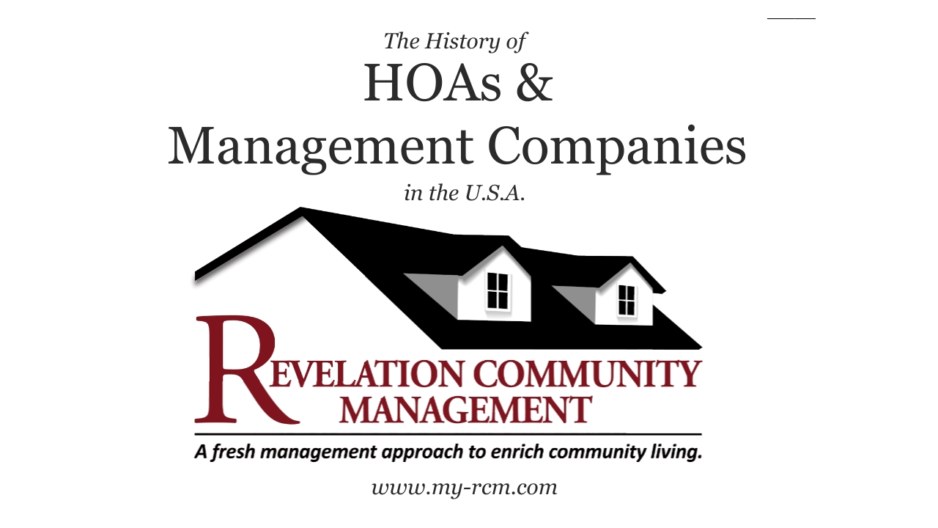The History of HOAs and Management Companies in the USA
It could be argued that HOAs formed in the latter part of the 1800’s when CIDs (Common Interest Developments) were introduced to “homesteaders” who used shared roads, fences, utilities and other essential services. However, the real growth of what initiated today’s HOAs did not really begin until the early 1900’s.
The growth of today’s HOAs did not really begin until the early 1900’s when they were started in California. Notably in 1905 the Arroyo Seco Improvement Association was founded in Pasadena around and the Los Feliz Improvement Association in Los Angeles founded in 1916.
These restrictions imposed established the national legal precedent for zoning districts exclusively for upscale, single-family residences. Keep in mind, things were considerably different in the early 1900’s because most people were living within the bigger cities. Keep in mind that back in that time, what we refer to today as ‘the suburbs’ did not exist.
It was not until 1963 until real change began. It was then that the FHA approved Federal Home Mortgage Insurance exclusively for condominiums or for homes in subdivisions that had a qualifying homeowner association.
This created an explosion of construction of condominiums and subdivisions creating an exodus of the city dwellers to move to the suburbs and into common-interest housing. Helping the cause was the rapid expansion of federally subsidized highways under federal programs made access to new areas easy.
And then came July 2, 1964. That was when the Civil Rights Act was introduced into American law by United States President Lyndon B. Johnson during the King assassination riots. As an add-on to the Civil Rights Act the Fair Housing Act expanded on previous acts and prohibited discrimination concerning the sale, rental, and financing of housing based on race, religion, national origin, and since 1974, sex. Since then, several other protections have been added that protects people with disabilities, families with children, pregnant women and sex.
This movement to the suburbs started the race for developers to find useable space for suburban development. This resulted in escalating land costs, prompting developers to increase the density of homes on the land. In order to do this while still retaining a suburban look, they clustered homes around green open areas maintained by associations.
It was the U.S. Clean Water Act of 1977 that advocated even more for HOAs. This required that all new real estate developments had to detain stormwater so that flow to adjoining properties was no greater than the pre-development runoff. It was then that nearly all residential developments had to construct detention or retention areas to hold excess stormwater.
Since these detention areas serve multiple residences, they are almost always designated as “common” areas. This requirement was only another reason developers had to establish a homeowner association. Now nearly all U.S. municipalities require these areas to be part of a common area to ensure an entity, rather than an individual or the municipality itself, has maintenance responsibility.
By establishing an HOA, the developers can now have expanded scope, giving them authority to regulate changes to residences, landscaping and maintenance requirements, color of houses, etc., a variety of other requirements and amenities that the developers believe will make their project more desirable to the market.
In todays times, the major power of the HOA is the ability to compel property owners to pay a share of common expenses for the overall maintenance of the HOA and the amenities, usually proportionate to the ownership interests (either by unit or based on square footage). These expenses generally arise from the operation and maintenance of common property, which vary dramatically depending on the type of association.
This is why many HOAs hire specialized management companies to handle the governing duties of the association. Management services for HOAs are typically divided into three categories:
- Financial only: Financial services typically cover administration of bank accounts, bookkeeping, assessment collection, and the HOAs budget.
- Full management: Full management companies typically includes the financial services plus help with board meetings (keeping minutes, agendas, etc.), board elections, and maintenance duties (obtaining contractor bids, etc.).
- On-site management: On-site management typically includes all of the full management services plus direct assistance to homeowners with an assigned manager to the HOA.
Is your HOA seeking an experienced management company in the Carolina’s? If so, we hope you will consider Revelation Community Management. We’ve designed our premium services to serve as the backbone of communities and to ensure board members have the resources and support they need to maintain a thriving and healthy community environment.

